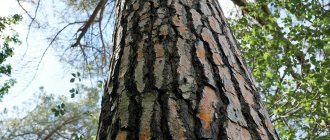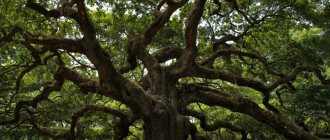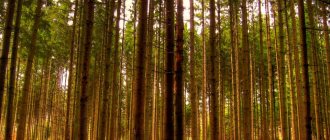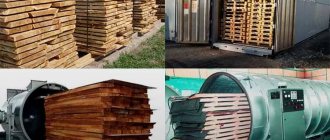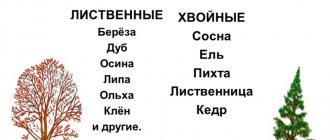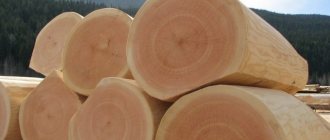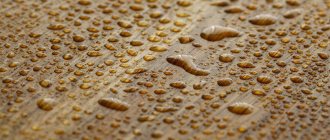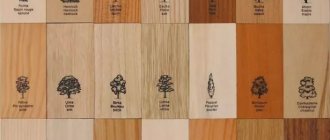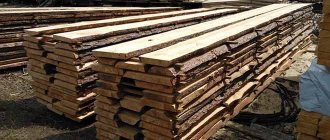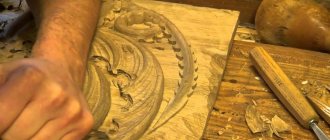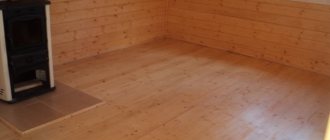Those who decide to build a wooden house for themselves and their family most often choose coniferous wood as the main building material. And this is understandable, since they are the ones that are optimally suited in terms of their physicochemical properties.
And yet, deciduous trees are also used in housing construction, although much less frequently. There are many reasons for this. If deciduous wood is truly reliable and of high quality, then it will cost much more than coniferous wood. Deciduous wood is more beautiful and original in structure, so the future homeowner will have a difficult choice - is he willing to pay for additional beauty?
Definition
Deciduous wood species grow in temperate climates, with standard seasonal alternation - spring, summer, autumn, winter.
Trees in deciduous forests reach a height of 25-30 meters. They are predominantly distributed in the northern hemisphere of the planet (North America, western and eastern Europe, eastern regions of Asia), but are also found in the southern hemisphere (Chile, Argentina).
Deciduous forests can grow separately, or they can be part of mixed forests.
Oak wood and its quality
If you choose among the most common deciduous species the one that is close to coniferous in its qualities and consumer properties, then oak is out of competition. From this wood you can really build a comfortable house that will serve for a long time without any problems.
Oak wood has a high level of strength and density. And the older the tree, the higher these indicators. So such deciduous wood can easily compete in its characteristics with the best coniferous species. Those who often work with it unequivocally claim that this is a material with “character”.
If coniferous wood is distinguished by a high content of resins and essential oils, which largely determines its qualities, then oak materials are distinguished by an abundance of tannins. It is this fact that makes this category of wood extremely resistant to decay processes. Moreover, it has excellent bactericidal properties, which has a positive effect on the microclimate in a house made from such a log house. In ancient times, well frames were made from oak, since it purified and healed the water and kept it fresh.
So, a house with an oak frame will be strong, resistant to rot and fungus, durable, and healthy. But, naturally, in this barrel of honey there is also a fly in the ointment. The main problem is the excessively high cost of such a structure. A slightly smaller problem is the likelihood of oak wood cracking if it dries out.
Classification of hardwoods
Hardwood
In forestry, it is customary to divide species according to the physical properties of the wood. Among them are:
- Hardwoods (beech, hornbeam, oak, ash);
- Soft-leaved trees (linden, poplar, aspen, willow).
Light-loving plants usually grow faster than their shade-tolerant counterparts. Deciduous trees also differ in frost resistance. Some of them, such as aspen and birch, are very adapted to frosty periods, but plum or apricot, for example, without reliable shelter in winter, may die.
Wood hardness
Usually determined by the Brinell method. To do this, a hardened steel ball with a diameter of 10 mm is pressed with a force of 100 kg into the surface of the wood, the hole is measured and the hardness value is calculated.
To the right of the Brinell hardness is the Yankee hardness test. Expressed as the force (in pounds) that must be applied to a metal ball with a diameter of 0.444 inches (11.28 millimeters) to press it half its diameter into the wood.
The harder the wood, the higher the coefficient. The hardness of wood within the same species may differ depending on the cut (for example, dies of a radial cut will be harder than a tangential one). The table shows average values.
Hardness of wood species
The hardness of timber is its ability to resist the penetration of harder bodies, for example, nails and screws.
The hardness of wood varies in different cutting directions. The following types of hardness are distinguished:
- end This type of hardness is determined by pressing a metal rod, which has a hemispherical end with a diameter of 11.28 mm. The rod is pressed to a radius depth of 5.64 mm gradually over 2 minutes. The size of the print is 1 square centimeter and therefore hardness is measured in kg/cm2
- radial
- tangential
The lateral hardness of coniferous varieties of timber is most often 40% lower than the end hardness, and for deciduous varieties it is approximately 30%. The tangential type of hardness, for example, of oak, beech or elm timber is almost 5-10% higher than the end hardness. Most types of wood have approximately the same tangential and radial hardness.
In order to create a high-quality product from wood, it is necessary to determine the hardness of the type of wood used. Most often, the Brinell method is used to determine hardness. The meaning of this method is to press a metal ball with a diameter of 10 mm into the surface of the workpiece with a force of 100 kg. The hardness value is determined by the type of deformation and the diameter of the resulting depression.
In addition, experienced craftsmen must take into account changes in hardness that may occur while working with workpieces. For example, the hardness of timber varies depending on the type of cut.
Wood density table
According to the latest amendment “SP 64.13330.2017” dated 2022 made in “SNiP II-25-80 Wooden Structures”, the section regarding wood densities looks like this:
Density of wood and wood materials
- To determine the dead weight of structures, the density of wood of various species should be taken according to the following table:
| Wood type | Wood density, kg/m³, in structures for operating conditions according to Table 1 | |
| 1A, 1 and 2 | 3 and 4 | |
| Conifers: | ||
| larch | 650 | 800 |
| pine, spruce, cedar, fir | 500 | 600 |
| Hard deciduous: | ||
| oak, birch, beech, ash, maple, hornbeam, acacia, elm, and elm | 700 | 800 |
| Soft deciduous: | ||
| aspen, poplar, alder, linden | 500 | 600 |
- The density of freshly cut coniferous and soft deciduous wood should be taken equal to 850 kg/m³, hard deciduous wood - 1000 kg/m³.
- The density of laminated wood should be taken as that of non-glued wood.
- The density of ordinary plywood should be taken equal to the density of veneer wood, and bakelized plywood - 1000 kg/m³.
- The density of wood made from unidirectional veneer is 500-600 kg/m³, depending on the type of wood veneer.
Tapeworms - individual plantings of deciduous crops
For tapeworms, trees are selected with a well-formed or bizarre crown, unusual foliage, adapted to growing conditions, and resistant to damage by pests and viral infections.
Large estates are decorated with linden, chestnut, and maple trees. When planted separately, the tree trunk branches almost near the ground. As they grow, small branches intertwine and create openwork patterns. In winter, a tapeworm, devoid of foliage, sprinkled with snow, also looks very impressive.
In small areas, rowan berries, willows, some types of hawthorns, and maples are used for isolated plantings. They branch at a certain height, but the beautifully curved branches reach the ground and form a green, lush tent.
Group plantings, compositions
It is customary to select an odd number of plants for compositions. The constant companions of oak are linden, maple, rowan, and ash. They develop harmoniously in the shade of a luxurious oak, emphasize its grandeur, and increase the aesthetics of the planting.
Birch trees are planted to mark alleys and site boundaries. The culture is attractive in small single-species plantings; in multi-stemmed groups it is combined with linden and elm.
Hedges are often formed from linden and maple trees. Group plantings combine woody plants with different flowering periods, original shapes of leaf blades, and bark. The compositions have a pronounced decorative effect, retain it throughout the season and effectively decorate the area.
Alder, birch, and aspen exquisitely complement the conifers.
Information about the macroscopic structure of wood
Main cuts and parts of the trunk
Due to the difference in structure and properties in different structural directions, wood is studied in three main sections: transverse, radial and tangential (Fig. 1). The plane of the transverse section runs perpendicular to the axis of the trunk; radial - along the axis of the trunk through the core; tangential - along the axis of the trunk at a certain distance from the core.
In a cross section, three main parts of the trunk can be distinguished: pith, wood and bark (Fig. 2). The core has the appearance of a dark speck with a diameter of 2-5 mm, consists of soft, loose tissue and is located approximately in the center of the cross-section of the trunk. Wood occupies most of the volume of the trunk and is located between the core and bark. The bark covers the trunk in a continuous ring. There are two layers in the bark: the outer one - the crust, which protects the trunk tissue from sudden changes in temperature and mechanical damage, and the inner one - the phloem, directly adjacent to the cambium (living educational tissue). Water carrying organic nutrients produced in the leaves passes through the phloem.
Macrostructure of wood
Heartwood and sapwood.
In many breeds, the central part of the trunk is colored darker than the outer part. The dark-colored part is called the core, and the lighter, peripheral part is called sapwood (Fig. 2). The heartwood and sapwood differ not only in color. Sapwood when freshly cut contains more moisture than heartwood. The boundary between the heartwood and the sapwood can be sharp or blurred, and the sapwood itself can be wide or narrow.
Rocks that have a core are called sound rocks. Conifers include: pine, cedar pines, larch, yew, juniper; from deciduous trees: oak, ash, elm, acacia, poplar, walnut, etc. The remaining species, in which the wood is equally colored across the entire width of the trunk, are called coreless. The following do not have kernels: spruce, fir, birch, aspen, hornbeam, beech, linden, boxwood, etc. However, in some kernel-free species (birch, alder, maple, beech, etc.), darkening of the central part of the trunk is sometimes observed. Such a dark-colored zone is called a false core (see “Defects of wood”).
Annual layers. On the cross section of the trunk, concentric circles are visible, representing the annual growth of wood. These circles are called annual layers (Fig. 3). On a radial section they look like longitudinal stripes, on a tangential section they look like curved lines of a C-shape. Each annual layer consists of two parts: the inner one, located closer to the core, light and soft - early wood and the outer one, adjacent to the bark, dark and hard - late wood (Fig. 3). The distinction between earlywood and latewood is clearly expressed in conifers and some deciduous species.
Core rays and core repetitions. On the cross section of some hardwoods, light, shiny or matte lines are clearly visible, directed from the core to the bark along the radii - pith rays (Fig. 4). On a radial section they look like shiny dark or light horizontal stripes or ribbons. On the tangential view, the medullary rays are visible as short longitudinal lines, strokes or lenticular dashes. Depending on the breed, the medullary rays are wide or narrow (the width of the rays is determined on the cross section). Wide medullary rays are clearly visible to the naked eye in oak, beech, and sycamore. Narrow, difficult to detect rays are found in linden, maple, elm, etc. wood; very narrow, not at all visible to the naked eye, have coniferous and some deciduous. In alder, hornbeam and hazel, narrow rays sometimes come together in bunches and form so-called false-wide core rays. Such rays, unlike real ones, are matte, and their width decreases from the center of the trunk to the periphery.
In some deciduous trees (birch, alder, maple, willow, aspen, pear, rowan), brownish or brownish narrow stripes, dashes, and specks are visible on longitudinal sections of the wood (Fig. 5). These formations are called core repeats. Most often they are found in the lower part of the trunk. In birch, alder, and pear, core repetitions are so common that they can serve as a diagnostic feature of the breed.
Vessels. In the cross-section of deciduous wood, holes are visible, which are cross-sections of vessels - tubes, channels designed to conduct water. According to their size, vessels are divided into large, clearly visible to the naked eye, and small, invisible to the naked eye.
In ring-vascular hardwoods, large vessels are located in the early wood, forming a clearly visible continuous ring of vessels in the cross section (Fig. 6). The accumulation of small vessels in these rocks forms the following types of groupings: radial
- light radial stripes (Fig. 6,
a
- oak, chestnut);
tangential
- light wavy lines parallel to the boundary of the annual layer (Fig. 6,
b
- elm, elm, velvet tree);
light dots or dashes (Fig. 6, c
- ash, pistachio, white acacia).
In diffusely vascular deciduous species, large and small vessels are evenly distributed throughout the annual layer (Fig. 6, d - birch, beech, hornbeam, aspen, linden, alder, maple, etc.). In radial and tangential sections, the vessels have the appearance of longitudinal grooves.
Resin passages. In the wood of some coniferous species (pine, cedar pines, larch, spruce) there are vertical resin ducts - channels filled with resin. In a cross section, resin ducts are visible in the form of light dots located in the late wood of the annual layers (Fig. 7); on the longitudinal ones - in the form of dark strokes directed along the axis of the trunk. Horizontal resin ducts running in the medullary rays can only be detected under a microscope in a tangential section. The size and number of resin ducts depend on the type of wood. In pine and cedar pines they are large and numerous, in larch and spruce they are small and few in number. There are no resin passages in the wood of fir, yew and juniper.
Planting and caring for decorative species
Creating a landscape composition on a site begins with the placement of dominant plants. The choice of tree species composition is determined by: features of crop development, style orientation of design, size, topography of the site, composition, soil moisture, and other factors.
Growing several types of tree crops increases the likelihood of their preservation: pests and diseases often affect only certain species.
Oak
The mighty, sacred tree of the Slavs has many species. The most aesthetically pleasing ones in landscape projects are:
- English oak
- red oak
- sessile oak
